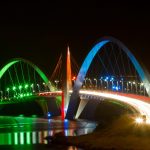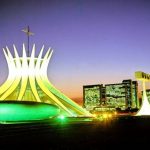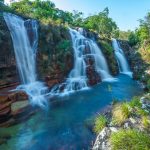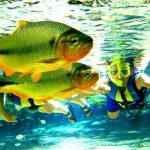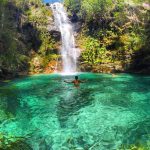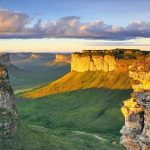The region encompasses the state of Mato Grosso, Mato Grosso do Sul and Goiás – besides the Federal district, seat of the country’s capital, Brasilia. Pantanal Mato Grossense, the widwest wetland in the country, is one of the major ecotourism destinations in the whole world. Brasília, designed through and through by Brazilian architect Oscar Niemaeyer, is the must go attraction for those interested in modernist architecture and design.
Perfect for: Families, adventure groups, esoteric or architecture lovers.
Best Time: Rainy season (October to March) to visit the Chapadas and Bonito for observe the flora and during the dry season ( May to September) to visit Pantanal and see animals and for fishing expedictions.
Brasília: Founded in 1960, the capital of Brazil bears the title of World’s Cultural Heritage, major landmark of modernist architecture the city was designed through and through by the urban planner Lucio Costa and the renowned architect Oscar Niemeyer. Since the very first stages of Brazil as a colony, the Portuguese had a plan of having the capital moved inland. It was, at the time, a strategy to protect the capital from pirate’s invasion. The site had been chosen – the center of the country – but it remained a dream until 1955 when Juscelino Kubitschek became President of Brazil. The transition between dream and reality was brought forth under Lucio Costa’s urban planning conception, poetically translated into a simple sign, like someone who possesses a place and in this place maps out two lines that cross symbolizing the Sign of the Cross. Brasília also existed in Saint John Bosco’s prophesy: “Between the parallels 15 and 20, is a very large and long riverbed that will become a lake in its beginning, when people hollow out the hidden mines among these hills, then the promised land will appear where milk and honey will sprout and there will be incredible richness”.
Chapada dos Veadeiros: Two hundred and twenty nine km. away from Brasilia, Alto Paraíso de Goiás is the ideal destination for esoteric people. The mystic-minded say the region is the magnetic heart of Brazil, a concept that took them to erect pyramid like buildings everywhere, but one has not to share in any esoteric philosophy or tradition to be charmed by magic scenary of Chapada dos Veadeiros National Park, with its rivers, waterfalls, natural pools and rocky formations which are home to the sheer variety of the typical animals and vegetation of the vast Brazilian grassland (” Cerrado”).
Pantanal: In the centre of the South American continent lays the largest inland delta in the world: the Pantanal. The origins of these floodplains probably go back to the time when there was a great inland sea in the South American continent. Today, life in the Pantanal follows a yearly cycle of rising and falling waters, dictated by the rains and the course of the great Paraguay river and its many meandering tributaries. The diversity of vegetation, the rich soil and the abundance of water attract and sustain an enormous variety and abundance of wildlife.
Pantanal North: A trip to the Northern part of Pantanal typically begins on the road BR 070. There are three principal destinations acessible from the capital of state of Mato Grosso, Cuiabá. The first one, Cárceres, 215 km. away, is a historic village at the margins of the Paraguai river, offering boat hotels and fishing facilities. A little bit closer to the capital, Poconé is acessible through the Transapantaneira, a road that cuts across the entire wetland country of Pantanal up to Porto Jofre, with serveral ecotourism hotels along the way, near the Cuiabá, but outside the wetlands area has another important ecotourism destination, the Chapada dos Guimarães.
Chapada dos Guimarães: The rocky plateau beginning about 60km. northeast of Cuiabá is a beautiful region reminiscent of the American Southwest. It is a perfect combination of grasslands, waterfalls, canyons and rock formations. It is three exceptional sights are the 60m. falls Cachoeira Veu da Noiva, the stupendous Mirante de Geodésia canyon and lookout and the Stone city.
Pantanal Sul: The main road to the southern Pantanal is BR262. the starting point is the capital of the state of Mato Grosso do Sul, Campo Grande. The fist stop in this intinerary is Aquidauana, a village combining rustic accomodation with fishing facilities. Miranda, home to several ecotourism oriented inns, is only 69 km. away Corumbá, at the Bolivian border, that is the main port for the hotels boats that tour about the Paraguai river. The so called Park road begins right here, at the intersection with BR262.
Bonito: This small town, 312km. away Campo Grande, in southwest Mato Grosso do Sul is undergoing an ecotourism boom because of the surrounding area caves, waterfalls and incredibly clear, forest lined rivers where divers can swin eyeball to eyeball with hundreds of fish. The name is so appropiete “Bonito” is handsome and the place is really provide of beauties places. Here nature lovers have a lot to see and do, starting from adventure sports, another great attraction in the Blue Lake cave whity its myriad of stalactites and stalagmites that serve as a natural frame to the deep blue lake that lies at the bottom. In addition to all these, you can still enjoy the waterfalls, trails, boia cross rides, etc.

